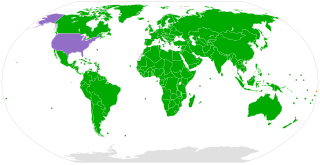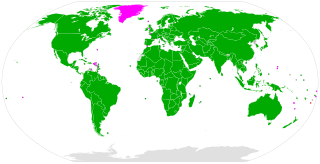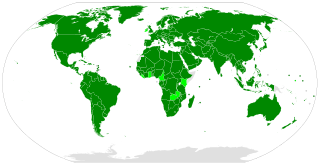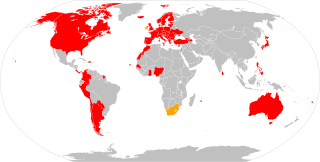
The United Nations Convention on the Rights of the Child is an international human rights treaty which sets out the civil, political, economic, social, health and cultural rights of children. The convention defines a child as any human being under the age of eighteen, unless the age of majority is attained earlier under national legislation.
Child sex tourism (CST) is tourism for the purpose of engaging in the prostitution of children, which is commercially facilitated child sexual abuse. The definition of child in the United Nations Convention on the Rights of the Child is "every human being below the age of 18 years". Child sex tourism results in both mental and physical consequences for the exploited children, which may include sexually transmitted infections, "drug addiction, pregnancy, malnutrition, social ostracism, and death", according to the State Department of the United States. Child sex tourism, part of the multibillion-dollar global sex tourism industry, is a form of child prostitution within the wider issue of commercial sexual exploitation of children. Child sex tourism victimizes approximately 2 million children around the world. The children who perform as prostitutes in the child sex tourism trade often have been lured or abducted into sexual slavery.

Child prostitution is prostitution involving a child, and it is a form of commercial sexual exploitation of children. The term normally refers to prostitution of a minor, or person under the legal age of consent. In most jurisdictions, child prostitution is illegal as part of general prohibition on prostitution.

The Convention Concerning the Prohibition and Immediate Action for the Elimination of the Worst Forms of Child Labour, known in short as the Worst Forms of Child Labour Convention, was adopted by the International Labour Organization (ILO) in 1999 as ILO Convention No 182. It is one of eight ILO fundamental conventions.

Commercial sexual exploitation of children (CSEC) is a commercial transaction that involves the sexual exploitation of a minor, or person under the age of consent. CSEC involves a range of abuses, including but not limited to: the, child pornography, stripping, erotic massage, phone sex lines, internet-based exploitation, and early forced marriage.

The Special Rapporteur on the Sale and Sexual Exploitation of Children works on behalf of the United Nations Human Rights Council to investigate the exploitation of children around the world and make recommendations to governments on how to end such practices.

The Optional Protocol on the Sale of Children, Child Prostitution and Child Pornography is a protocol to the Convention on the Rights of the Child and requires parties to prohibit the sale of children, child prostitution and child pornography.
The Protocol to Prevent, Suppress and Punish Trafficking in Persons, Especially Women and Children is a protocol to the United Nations Convention Against Transnational Organized Crime. It is one of the three Palermo protocols, the others being the Protocol Against the Smuggling of Migrants by Land, Sea and Air and the Protocol Against the Illicit Manufacturing of and Trafficking in Firearms.

The Committee on the Rights of the Child (CRC) is a body of experts that monitor and report on the implementation of the United Nations Convention on the Rights of the Child.

Human rights in Romania are generally respected by the government. However, there have been concerns regarding allegations of police brutality, mistreatment of the Romani minority, government corruption, poor prison conditions, and compromised judicial independence. Romania was ranked 59th out of 167 countries in the 2015 Democracy Index and is described as a "flawed democracy", similar to other countries in Central or Eastern Europe.

The Convention on Cybercrime, also known as the Budapest Convention on Cybercrime or the Budapest Convention, is the first international treaty seeking to address Internet and computer crime (cybercrime) by harmonizing national laws, improving investigative techniques, and increasing cooperation among nations. It was drawn up by the Council of Europe in Strasbourg, France, with the active participation of the Council of Europe's observer states Canada, Japan, the Philippines, South Africa and the United States.
Laws against child sexual abuse vary by country based on the local definition of who a child is and what constitutes child sexual abuse. Most countries in the world employ some form of age of consent, with sexual contact with an underage person being criminally penalized. As the age of consent to sexual behaviour varies from country to country, so too do definitions of child sexual abuse. An adult's sexual intercourse with a minor below the legal age of consent may sometimes be referred to as statutory rape, based on the principle that any apparent consent by a minor could not be considered legal consent.
Various groups have taken steps to combat growing commercial sexual exploitation of children and child pornography in the Philippines. In 2016, UNICEF declared that the Philippines is one of the top sources of child pornography.
Child pornography is illegal in most countries, but there is substantial variation in definitions, categories, penalties, and interpretations of laws. Differences include the definition of "child" under the laws, which can vary with the age of sexual consent; the definition of "child pornography" itself, for example on the basis of medium or degree of reality; and which actions are criminal. Laws surrounding fictional child pornography are a major source of variation between jurisdictions; some maintain distinctions in legality between real and fictive pornography depicting minors, while others regulate fictive material under general laws against child pornography.

Prostitution laws varies widely from country to country, and between jurisdictions within a country. At one extreme, prostitution or sex work is legal in some places and regarded as a profession, while at the other extreme, it is considered a severe crime punishable by death in some other places.

ECPAT International is a global network of civil society organisations that works to end the sexual exploitation of children. It focuses on ending the online sexual exploitation of children, the trafficking of children for sexual purposes, the sexual exploitation of children in prostitution, child, early and forced marriages, and the sexual exploitation of children in the travel and tourism industry.
The International Convention for the Suppression of the Traffic in Women and Children is a 1921 multilateral treaty of the League of Nations that addressed the problem of international trafficking of women and children.
The Federated States of Micronesia is a United States Associated State consisting of 4 states across the Western Pacific Ocean. The estimated population in 2015 was 105,216. Formerly the FSM was a part of the Trust Territory of the Pacific Islands (TTPI) but in 1979 formed its own constitutional government. FSM has a written constitution which took effect in 1979 and has been amended only once in 1990. By virtue of membership in the United Nations, the FSM abides by the UN Declaration of Human Rights (UDHR). Key human rights concerns in FSM include judicial delays, government corruption, discrimination against women, domestic violence and child neglect.
 Albania
Albania  Andorra
Andorra  Armenia
Armenia  Austria
Austria  Azerbaijan
Azerbaijan  Belgium
Belgium  Bosnia and Herzegovina
Bosnia and Herzegovina  Bulgaria
Bulgaria  Croatia
Croatia  Cyprus
Cyprus  Czech Republic
Czech Republic  Denmark
Denmark  Estonia
Estonia  Finland
Finland  France
France  Georgia
Georgia  Germany
Germany  Greece
Greece  Hungary
Hungary  Iceland
Iceland  Ireland
Ireland  Italy
Italy  Latvia
Latvia  Liechtenstein
Liechtenstein  Lithuania
Lithuania  Luxembourg
Luxembourg  Republic of Macedonia
Republic of Macedonia  Malta
Malta  Moldova
Moldova  Monaco
Monaco  Montenegro
Montenegro  Netherlands
Netherlands  Norway
Norway  Poland
Poland  Portugal
Portugal  Romania
Romania  Russia
Russia  San Marino
San Marino  Serbia
Serbia  Slovakia
Slovakia  Slovenia
Slovenia  Spain
Spain  Sweden
Sweden  Switzerland
Switzerland  Tunisia
Tunisia  Turkey
Turkey  Ukraine
Ukraine  United Kingdom
United Kingdom 








